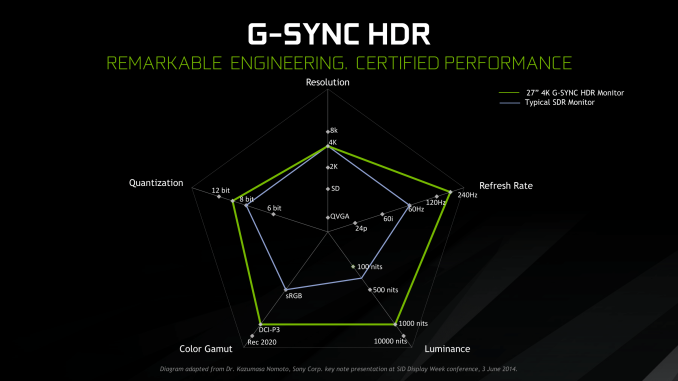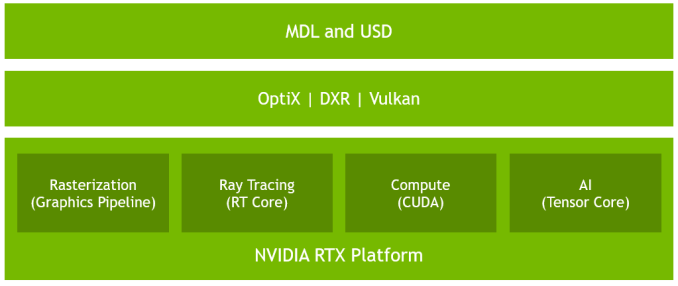The NVIDIA GeForce RTX 2080 Ti & RTX 2080 Founders Edition Review: Foundations For A Ray Traced Future
by Nate Oh on September 19, 2018 5:15 PM EST- Posted in
- GPUs
- Raytrace
- GeForce
- NVIDIA
- DirectX Raytracing
- Turing
- GeForce RTX
Meet The New Future of Gaming: Different Than The Old One
Up until last month, NVIDIA had been pushing a different, more conventional future for gaming and video cards, perhaps best exemplified by their recent launch of 27-in 4K G-Sync HDR monitors, courtesy of Asus and Acer. The specifications and display represented – and still represents – the aspired capabilities of PC gaming graphics: 4K resolution, 144 Hz refresh rate with G-Sync variable refresh, and high-quality HDR. The future was maxing out graphics settings on a game with high visual fidelity, enabling HDR, and rendering at 4K with triple-digit average framerate on a large screen. That target was not achievable by current performance, at least, certainly not by single-GPU cards. In the past, multi-GPU configurations were a stronger option provided that stuttering was not an issue, but recent years have seen both AMD and NVIDIA take a step back from CrossFireX and SLI, respectively.
Particularly with HDR, NVIDIA expressed a qualitative rather than quantitative enhancement in the gaming experience. Faster framerates and higher resolutions were more known quantities, easily demoed and with more intuitive benefits – though in the past there was the perception of 30fps as cinematic, and currently 1080p still remains stubbornly popular – where higher resolution means more possibility for details, higher even framerates meant smoother gameplay and video. Variable refresh rate technology soon followed, resolving the screen-tearing/V-Sync input lag dilemma, though again it took time to catch on to where it is now – nigh mandatory for a higher-end gaming monitor.
For gaming displays, HDR was substantively different than adding graphical details or allowing smoother gameplay and playback, because it meant a new dimension of ‘more possible colors’ and ‘brighter whites and darker blacks’ to gaming. Because HDR capability required support from the entire graphical chain, as well as high-quality HDR monitor and content to fully take advantage, it was harder to showcase. Added to the other aspects of high-end gaming graphics and pending the further development of VR, this was the future on the horizon for GPUs.
But today NVIDIA is switching gears, going to the fundamental way computer graphics are modelled in games today. Of the more realistic rendering processes, light can be emulated as rays that emit from their respective sources, but computing even a subset of the number of rays and their interactions (reflection, refraction, etc.) in a bounded space is so intensive that real time rendering was impossible. But to get the performance needed to render in real time, rasterization essentially boils down 3D objects as 2D representations to simplify the computations, significantly faking the behavior of light.
It’s on real time ray tracing that NVIDIA is staking its claim with GeForce RTX and Turing’s RT Cores. Covered more in-depth in our architecture article, NVIDIA’s real time ray tracing implementation takes all the shortcuts it can get, incorporating select real time ray tracing effects with significant denoising but keeping rasterization for everything else. Unfortunately, this hybrid rendering isn’t orthogonal to the previous concepts. Now, the ultimate experience would be hybrid rendered 4K with HDR support at high, steady, and variable framerates, though GPUs didn’t have enough performance to get to that point under traditional rasterization.
There’s a still a performance cost incurred with real time ray tracing effects, except right now only NVIDIA and developers have a clear idea of what it is. What we can say is that utilizing real time ray tracing effects in games may require sacrificing some or all three of high resolution, ultra high framerates, and HDR. HDR is limited by game support more than anything else. But the first two have arguably minimum performance standards when it comes to modern high-end gaming on PC – anything under 1080p is completely unpalatable, and anything under 30fps or more realistically 45 to 60fps hurts the playability. Variable refresh rate can mitigate the latter and framedrops are temporary, but low resolution is forever.
Ultimately, the real time ray tracing support needs to be implemented by developers via a supporting API like DXR – and many have been working hard on doing so – but currently there is no public timeline of application support for real time ray tracing, Tensor Core accelerated AI features, and Turing advanced shading. The list of games with support for Turing features - collectively called the RTX platform - will be available and updated on NVIDIA's site.













337 Comments
View All Comments
whaever85343 - Friday, September 21, 2018 - link
Whatever, this is your new benchmark:https://albertoven.com/2018/08/29/light-lands/
Golgatha777 - Friday, September 21, 2018 - link
I just want to be able to play all my games at 1440p, 60 FPS with all the eye candy turned on. Looks like my overclocked 1080 TI will be good for the immediate future is what I got from this review. The only real upgrade path is to the 2080 TI, and at $1200 that's an extremely hard sell.vivekvs1992 - Friday, September 21, 2018 - link
Well the problem is in India retailers are not willing to reduce the price of 1080 deries.. At present the 2080 is cheaper than all models of 1080 ti.. If given the chance I will definitely go for 2080..thing is that I will have to invest in a gaming monitor firstwebdoctors - Friday, September 21, 2018 - link
Any mining benchmarks?Can I actually make money buying these cards?
ravyne - Friday, September 21, 2018 - link
I agree these are really for early-adopters of RT, or if you're doing a new build or need of a new card but want it to last you 3+ years, so you need to catch the RT wave now.I think the next generation of RT-enabled cards will probably be the optimal entry-point; Presumably they'll be able to double (or so) RT performance on a 7nm process, and that means that the next xx70/80 products will actually have enough RT to match the resolution/framerate expectations of a high-end card, and also that the RT core won't be too costly to put into xx50/60 tier SKUs (If we even see a 2060 SKU, I don't think it will include RT cores at all, simply because the performance it could offer won't really be meaningful).
More than a few things are conspiring against the price too -- Aside from the specter of terriffs, the high price of all kinds of RAM right now, and that this is a 12nm product rather than 7nm, it looks to me like the large and relatively monolithic nature of the RT core itself is preventing nV from salvaging/binning more dies -- with the cuda/tensor cores I'd imagine they build in some redundant units so they can salvage the SM even if there are minor flaws in the functional units, but since there's only 1 RT core per SM, any flaw there means the whole SM is out -- that explains why the 2080 is based on the same GPU as the TI, and why the 2070 is the only card based on the GPU that would normally serve the xx70 and xx80 SKUs. Its possible they might be holding onto the dies with too many flawed RT cores to re-purpose them for the AI market, but that would compete with existing products.
gglaw - Saturday, September 22, 2018 - link
Is there a graph error for BF1 99th percentile at 4k resolution? The 2080 TI FE is at 90, and the 2080 TI (non founders) is 68. How is it possible to have this gigantic difference when almost all other benchmarks and games they are neck and neck?vandamick - Saturday, September 22, 2018 - link
A GTX 980 user. Would the RTX2080 be a big upgrade? Or should I stick with the 1080Ti that I had earlier planned? My upgrade cycle is about 3 years.Inteli - Saturday, September 22, 2018 - link
Are you willing to pay the extra $1-200 for a 2080 over a 1080 Ti for the same performance in current games, in exchange for the new Turing features (Ray-tracing and DLSS)?I'm not convinced yet that the 2080 will be able to run ray-traced games at acceptable frame rates, but it is "more future-proof" for the extra money you pay.
mapesdhs - Thursday, September 27, 2018 - link
Thing is, for the features you're talking about, the 2080 _is not fast enough_ at using them. I don't understand why more people aren't taking this onboard. NVIDIA's own demos show this to be the case, at least for RT. DLSS is more interesting, but the 2080 has less RAM. Until games exist that make decent use of these new features, buying into this tech now when it's at such a gimped low level is unwise. He's far better off with the 1080 Ti, that'll run his existing games faster straight away.AshlayW - Saturday, September 22, 2018 - link
They've completely priced me out of the entire RTX series lol. My budget ends at £400 and even that is pushing it :(